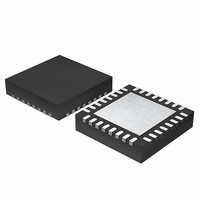EFM32G200F64 Energy Micro, EFM32G200F64 Datasheet - Page 58

EFM32G200F64
Manufacturer Part Number
EFM32G200F64
Description
MCU 32BIT 64KB FLASH 32-QFN
Manufacturer
Energy Micro
Series
Geckor
Datasheets
1.EFM32G200F16.pdf
(63 pages)
2.EFM32G200F16.pdf
(10 pages)
3.EFM32G200F16.pdf
(463 pages)
4.EFM32G200F16.pdf
(136 pages)
Specifications of EFM32G200F64
Core Processor
ARM® Cortex-M3™
Core Size
32-Bit
Speed
32MHz
Connectivity
EBI/EMI, I²C, IrDA, SmartCard, SPI, UART/USART
Peripherals
Brown-out Detect/Reset, DMA, POR, PWM, WDT
Number Of I /o
24
Program Memory Size
64KB (64K x 8)
Program Memory Type
FLASH
Ram Size
16K x 8
Voltage - Supply (vcc/vdd)
1.8 V ~ 3.8 V
Data Converters
A/D 4x12b, D/A 1x12b
Oscillator Type
External
Operating Temperature
-40°C ~ 85°C
Package / Case
32-VQFN Exposed Pad
Processor Series
EFM32G200
Core
ARM Cortex-M3
Data Bus Width
32 bit
Data Ram Size
16 KB
Interface Type
I2C, UART
Maximum Clock Frequency
32 MHz
Number Of Programmable I/os
24
Number Of Timers
2
Operating Supply Voltage
1.8 V to 3.8 V
Maximum Operating Temperature
+ 85 C
Mounting Style
SMD/SMT
Minimum Operating Temperature
- 40 C
Lead Free Status / RoHS Status
Lead free / RoHS Compliant
Eeprom Size
-
Lead Free Status / Rohs Status
Details
Available stocks
Company
Part Number
Manufacturer
Quantity
Price
3.5.1.3 Restrictions
3.5.1.4 Condition flags
3.5.1.5 Examples
2011-02-04 - d0002_Rev1.00
The SBC instruction subtracts the value of Operand2 from the value in Rn. If the carry flag is clear, the
result is reduced by one.
The RSB instruction subtracts the value in Rn from the value of Operand2. This is useful because of
the wide range of options for Operand2.
Use ADC and SBC to synthesize multiword arithmetic, see Section 3.5.1.6 (p. 59) .
See also Section 3.4.1 (p. 46) .
Note
In these instructions:
• Operand2 must not be SP and must not be PC
• Rd can be SP only in ADD and SUB, and only with the additional restrictions:
• Rn can be SP only in ADD and SUB
• Rd can be PC only in the ADD{cond} PC, PC, Rm instruction where:
• with the exception of the ADD{cond} PC, PC, Rm instruction, Rn can be PC only in ADD and SUB,
When Rd is PC in the ADD{cond} PC, PC, Rm instruction:
• bit[0] of the value written to the PC is ignored
• a branch occurs to the address created by forcing bit[0] of that value to 0.
If S is specified, these instructions update the N, Z, C and V flags according to the result.
• Rn must also be SP
• any shift in Operand2 must be limited to a maximum of 3 bits using LSL
• you must not specify the S suffix
• Rm must not be PC and must not be SP
• if the instruction is conditional, it must be the last instruction in the IT block
and only with the additional restrictions:
• you must not specify the S suffix
• the second operand must be a constant in the range 0 to 4095.
Note
ADD
SUBS
RSB
ADCHI
ADDW is equivalent to the ADD syntax that uses the imm12 operand. SUBW is equivalent to
the SUB syntax that uses the imm12 operand.
• When using the PC for an addition or a subtraction, bits[1:0] of the PC are rounded
• If you want to generate the address of an instruction, you have to adjust the constant
R2, R1, R3
R8, R6, #240
R4, R4, #1280
R11, R0, R3
to b00 before performing the calculation, making the base address for the calculation
word-aligned.
based on the value of the PC. ARM recommends that you use the ADR instruction
instead of ADD or SUB with Rn equal to the PC, because your assembler automatically
calculates the correct constant for the ADR instruction.
; Sets the flags on the result
; Subtracts contents of R4 from 1280
; Only executed if C flag set and Z
; flag clear
...the world's most energy friendly microcontrollers
58
www.energymicro.com


















